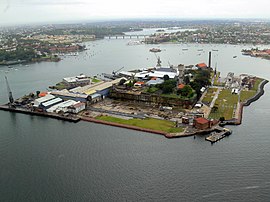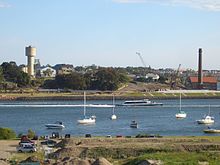| Cockatoo Island Wareamah Sydney, New South Wales | |||||||||||||||
|---|---|---|---|---|---|---|---|---|---|---|---|---|---|---|---|
| Nearest town or city | Woolwich | ||||||||||||||
| Coordinates | 33°50′51″S 151°10′21″E / 33.84750°S 151.17250°E | ||||||||||||||
| Postcode(s) | 2110 | ||||||||||||||
| Area | 0.179 km2 (0.1 sq mi) | ||||||||||||||
| Location | 4 km (2 mi) northwest of CBD | ||||||||||||||
| Managing authorities | Sydney Harbour Federation Trust | ||||||||||||||
| Website | Cockatoo Island | ||||||||||||||
| |||||||||||||||
| UNESCO World Heritage Site | |
|---|---|
 | |
| Part of | Australian Convict Sites |
| Criteria | Cultural: iv, vi |
| Reference | 1306-010 |
| Inscription | 2010 (34th Session) |



Cockatoo Island Wareamah is a UNESCO World Heritage Site[1] at the confluence of the Parramatta River and Lane Cove River in Sydney Harbour, New South Wales, Australia.
Cockatoo Island is the largest of several harbour islands that were once heavily timbered sandstone knolls. Originally the Island rose to 18 m (59 ft) above sea level and was 12.9 hectares (32 acres) but it has been extended to 17.9 ha (44 acres) and is now cleared of most vegetation.[2] Called Wa-rea-mah by the Indigenous Australians who traditionally inhabited the land prior to European settlement, the island may have been used as a fishing base, although physical evidence of Aboriginal heritage has not been found on the island.[3]
Between 1839 and 1869, Cockatoo Island operated as a convict penal establishment, primarily as a place of secondary punishment for convicts who had re-offended in the colonies.[4][5][6]
Cockatoo Island was also the site of one of Australia's biggest shipyards, operating between 1857 and 1991. The first of its two dry docks was built by convicts. Listed on the National Heritage List, the island is significant for its demonstration of the characteristics of a long-running dockyard and shipbuilding complex, including evidence of key functions, structures and operational layout. Cockatoo Island contains the nation's most extensive and varied record of shipbuilding, and has the potential to enhance understanding of maritime and heavy industrial processes in Australia from the mid-19th century.[6]
In July 2010, UNESCO proclaimed Cockatoo Island as a World Heritage Site,[1] and has been managed by the Sydney Harbour Federation Trust since 2001.
- ^ a b Chalmers, Emma; Martin, Saray (1 August 2010). "World Heritage Committee approves Australian Convict Sites as places of importance". The Courier–Mail. Australia. Archived from the original on 3 June 2012. Retrieved 8 September 2012.
- ^ "Sydney Harbour Federation Trust Management Plan – Cockatoo Island Part 1" (PDF). Sydney Harbour Federation Trust. Australian Government. 23 June 2010. p. 10. Archived (PDF) from the original on 12 February 2014. Retrieved 30 September 2014.
- ^ "Management Plan – Cockatoo Island" (PDF). Commonwealth of Australia: Sydney Harbour Federation Trust. 23 June 2010. Archived from the original (PDF) on 1 December 2012. Retrieved 8 September 2012.
- ^ Executive summary. Commonwealth of Australia: Department of the Environment, Water, Heritage and the Arts. January 2008. ISBN 978-0-642-55390-4. Archived from the original on 25 September 2012. Retrieved 8 September 2012.
{{cite book}}:|work=ignored (help) - ^ "2. Description". Australian convict sites: World Heritage Nomination (PDF). Commonwealth of Australia: Department of Sustainability, Environment, Water, Population and Communities. January 2008. pp. 36–37. ISBN 978-0-642-55390-4. Archived from the original (PDF) on 28 June 2012. Retrieved 8 September 2012.
- ^ a b "Cockatoo Island: more information". National heritage places. Commonwealth of Australia: Department of Sustainability, Environment, Water, Population and Communities. 15 May 2008. Archived from the original on 8 October 2012. Retrieved 8 September 2012.
